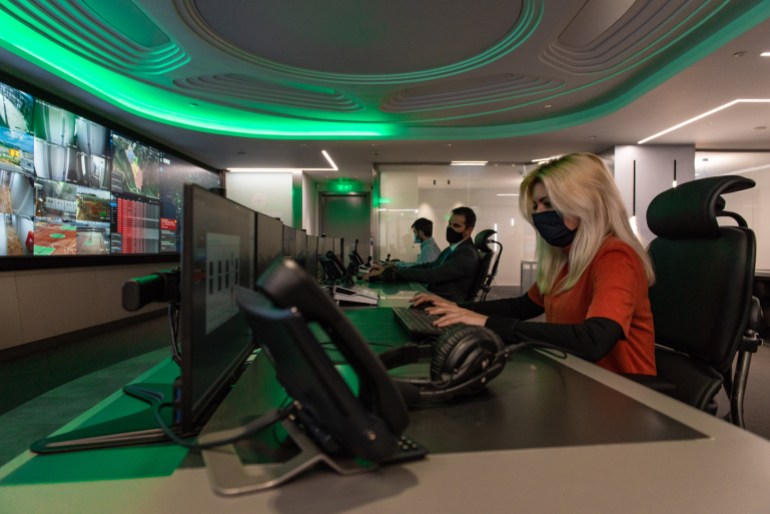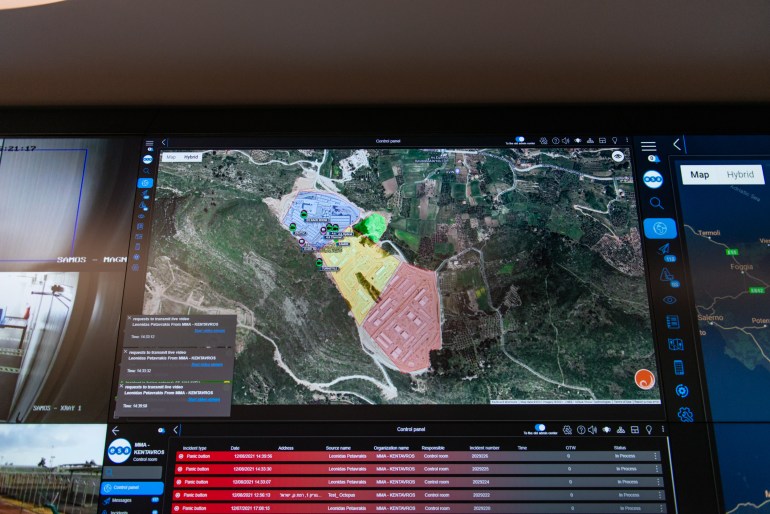Athens, Greece – “Let’s go see something that looks really nice,” says Anastasios Salis, head of information and communications technology at the Greek Migration and Asylum Ministry in Athens, before entering an airtight room sealed behind two interlocking doors, accessible only with an ID card and fingerprint scan.
Beyond these doors is the ministry’s newly-installed centralised surveillance room.
The front wall is covered by a vast screen. More than a dozen rectangles and squares display footage from three refugee camps already connected to the system.
Some show a basketball court in a refugee camp on the island of Samos. Another screen shows the playground and another the inside of one of the containers where people socialise.
Overhead, lights suddenly flash red. A potential threat has been detected in one of the camps. This “threat” has been flagged by Centaur, a high-tech security system the Greek Migration Ministry is piloting and rolling out at all of the nearly 40 refugee camps in the country.
Centaur includes cameras and motion sensors. It uses algorithms to automatically predict and flag threats such as the presence of guns, unauthorised vehicles, or unusual visits into restricted areas.
The system subsequently alerts the appropriate authorities, such as the police, fire brigade, and private security working in the camps.
From the control room, operators deploy camera-equipped drones and instruct officers stationed at the camp to rush to the location of the reported threat.
 Control room operators simulate an emergency protocol at the Ministry of Migration and Asylum in Athens, Greece [Kenya-Jade Pinto/Al Jazeera]
Control room operators simulate an emergency protocol at the Ministry of Migration and Asylum in Athens, Greece [Kenya-Jade Pinto/Al Jazeera]Officers carry smartphones loaded with software that allows them to communicate with the control centre.
Once they determine the nature and severity of the threat, the control room guides them on the ground to resolve the incident.
Video footage and other data collected as part of the operation can then be stored under an “incident card” in the system.
This particular incident is merely a simulation, presented to Al Jazeera during an exclusive tour and preview of the Centaur system.
The aim of the programme, according to Greek officials, is to ensure the safety of those who live inside the camps and in surrounding communities.
“We use technology to prevent violence, to prevent events like we had in Moria – the arson of the camp. Because safety is critical for everyone,” Greek Migration Minister Notis Mitarachi told Al Jazeera at the November inauguration of a new, EU-funded “closed-controlled” refugee camp on Kos island, one of the first facilities to be connected to the Centaur system.
‘Dystopian’ surveillance project
Nearly 40 cameras are being installed in each camp, which can be operated from the control room.
There will also be thermal cameras, drones, and other technology – including augmented reality glasses, which will be distributed to police and private security personnel.
“This was not to monitor and invade the privacy of the people [in the camps],” said Salis, one of the architects of Centaur. “You’re not monitoring them. You’re trying to prevent bad things from happening.”
Greek authorities headline this new surveillance as a form of security but civil society groups and European lawmakers have criticised the move.
“This fits a broader trend of the EU pouring public money into dystopian and experimental surveillance projects, which treat human beings as lab rats,” Ella Jakubowska, policy and campaigns officer at European Digital Rights (EDRi), told Al Jazeera. “Money which could be used to help people is instead used to punish them, all while the surveillance industry makes vast profits selling false promises of magical technology that claims to fix complex structural issues.”
Recent reporting, which revealed Centaur will be partly financed by the EU COVID Recovery fund, has led a group of European lawmakers to write to the European Commission with their concerns about its implementation.
Homo Digitalis, a Greek digital rights advocacy group, and EDRi said they made several requests for information on what data protection assessments were carried out before the development and deployment of Centaur.
Such analysis is required under the EU’s General Data Protection Regulation (GDPR). They have also asked what data will be collected and how long it will be held by authorities. Those requests, they said, have gone unanswered.
The Greek Migration Ministry did not respond to Al Jazeera’s query on whether an impact assessment was completed, and on policies regarding data retention and the processing of data related to children.
In Samos, mixed feelings
Advocates in Samos told Al Jazeera they raised concerns about camp residents being adequately notified about the presence of these technologies.
But Salis, at the control centre, said this has been achieved through “signs – a lot of signs”, in the camps.
The system does not currently incorporate facial recognition technology, at least “not yet”, according to Leonidas Petavrakis, a digital software specialist with ESA Security Solutions S.A., one of the companies contracted for the Centaur project.
The potential use of facial recognition in this context is “a big concern”, said Konstantinos Kakavoulis of Homo Digitalis.
Facial recognition systems often misidentify people of colour and can lead to wrongful arrests and convictions, according to studies. Human rights organisations globally have called for their use to be limited or banned.
An EU proposal on regulating artificial intelligence, unveiled by the European Commission in April, does not go far enough to prevent the misuse of AI systems, critics claim.
 A map of the closed and controlled access centre on Samos highlights the type of cameras used throughout the camp [Kenya-Jade Pinto/Al Jazeera]
A map of the closed and controlled access centre on Samos highlights the type of cameras used throughout the camp [Kenya-Jade Pinto/Al Jazeera]For some of those living under the glare of this EU-funded surveillance system, the feeling is mixed.
Mohammed, a 25-year-old refugee from Palestine living in the new Samos camp, said that he did not always mind the cameras as he thought they might prevent fights, which broke out frequently at the former Samos camp.
“Sometimes it’s [a] good feeling because it makes you feel safe, sometimes not,” he said but added that the sense of security came at a price.
“There’s not a lot of difference between this camp and a prison.”
